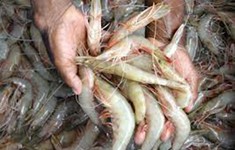 India sold 77,865 tons valued at USD 172 million (EUR 134 million) to China in 2012, said Shri N Ramesh, director of marketing at India’s Marine Products Export Development Authority (MPEDA). USDA and data from China shows India shipped USD 149 million (EUR 116 million) worth of product in 2011.
India sold 77,865 tons valued at USD 172 million (EUR 134 million) to China in 2012, said Shri N Ramesh, director of marketing at India’s Marine Products Export Development Authority (MPEDA). USDA and data from China shows India shipped USD 149 million (EUR 116 million) worth of product in 2011.“There was no significant drop in exports to China in 2012,” said Ramesh, though MPEDA’s figures contradict data from USDA that suggests India’s exports to China dropped sharply in 2012 on 2011. Shipments from January to October totaled USD 78 million (EUR 61 million), according to the USDA data that shows India in 2011 sold USD 149 million (EUR 116 million) worth of seafood to China.
New requirements by China’s quarantine authorities have increased costs for Indian seafood exporters shipping to China, claims the spokesman at MPEDA, a unit of the Indian ministry of commerce. A requirement by China’s General Administration of Quality Supervision, Inspection and Quarantine (AQSIQ) for a certificate from the exporting country competent authority (EIC in case of India) for every consignment has “increased the transaction cost,” Ramesh told SeafoodSource.
The top three categories of Indian exports to China in 2012 were frozen shrimp at 3,694 metric tons (MT) and USD 25.81 million (EUR 20 million), followed by frozen fish at 61,795 MT and USD 117.67 (EUR 92 million) respectively. Species with the highest demand this year are Vannamei shrimp, ribbon fish, yellow and silver croaker as well as pomfret, squid and cuttlefish. India also exports significant amounts of sole, eel and reef cod to China.
A free trade agreement between India and the Association of Southeast Asian Nations (ASEAN) means some of India’s products may be going through ASEAN states, which also have a free trade pact with China. While ASEAN exports to China have soared, prices for lower value fish compare unfavorably to prices earned in export markets like the EU and U.S. Indeed, future export volumes to China will “depend on the offer made by the Chinese buyers,” said Ramesh.
There are other signals that India may be shifting its focus to a higher-margin sustainable brand of seafood, leaving lower value processing to China. India retains many export advantages, explained Ramesh. Aside from volume, “about 70 percent of our shrimp exports are produced by sustainable and traditional aquaculture.”
“Through the effective regulations and stricter quality control regime by MPEDA, Indian seafood exporters are able to maintain their track record of exporting residue free aquaculture products to U.S., EU, Japan and other leading markets. Indian capture fisheries are managed sustainably, with stricter monitoring and nationwide conservation measures like fishing bans for 45 to 65 days. Also, we have limited fishing vessels (90 percent of which are traditional fishing crafts) and no industrial fishing vessel or activity.”
“Indian seafood has a very good reputation and demand due to quality and consistent supply and [because we are] not necessarily operating on price factor,” said Ramesh.
While MPEDA has yet to open its office in Beijing — as it said it would in 2011— the country appears set to increase its marketing presence in its giant neighbor. For instance, the India pavilion at the 2013 fishery expo in Dalian will be doubled in size in 2013. “We would also like to explore publishing ads in seafood related magazines in China. The Embassy of India in Beijing has posted a separate link on their website for promotion of Indian seafood export. We are also in the process of translating our main publications into the Chinese language.”
Indian seafood firms like Mumbai-based Sonia Fisheries and Marine have been shipping significant amounts of ribbon fish, frozen, into China. Vendors from India have also sold quantities of kingfish, Indian mackerel and sardines. Indian-sourced cuttlefish from Yemen has also been shipped into China. Indian exporters have cited less penurious health and sanitary authorities as well as acceptance of whole-round fish and faster payment terms, compared to the EU market.






